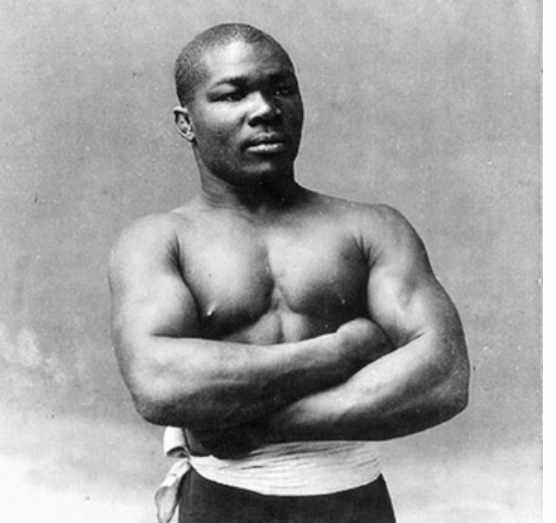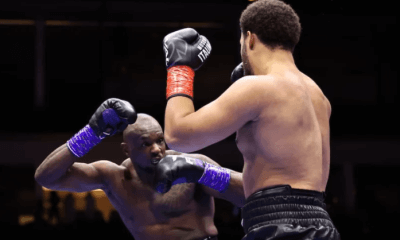Featured Articles
Whereabouts Unknown, but Quite Dead: The Sad Saga of Barbados Joe Walcott

The birth date of many antiquarian fighters is in dispute. Joe Walcott, whose name was adopted by a man who went on to win the world heavyweight title, is no exception. Named the greatest welterweight of all time by Nat Fleischer, Walcott was born on April 7, 1872 or March 13, 1873 depending on the source. But what’s unusual about Walcott is that even the date of his death is uncertain. Some say Oct. 1, 1935 and others pinpoint Oct. 4 of that year. Both dates are approximations.
Walcott was born in Guyana and spent his formative years in Barbados before arriving in Boston in his mid-teens. He supposedly arrived as a cabin boy on a ship and was marooned after overstaying his shore leave. When he took up boxing, he was working as an elevator operator or a piano mover. Again, reports differ. Regardless, Boston became his home and he remained in the Boston area for all but a few of the last years of his life.
As boxers go, Walcott was a freak of nature. He stood only five-foot-one-and-a-half, was barrel-chested with virtually no neck, and had extremely long arms. He held the welterweight title for the better part of four years beginning in 1901, but would be best remembered for conquering men much bigger than he.
Walcott was a stablemate of George “Little Chocolate” Dixon, a man who in his prime was rated the best pure boxer in the sport. When George Dixon hit the vaudeville circuit between important engagements, as was the custom for an important fighter in those days, the Barbados Demon, as he was called, often accompanied him, either serving as his valet or boxing a local man, perhaps a plant in the audience, in a bout with a short ceiling, customarily four rounds. On those occasions when he and Dixon were both “taking on all comers,” the audience got a doubleheader. Walcott also frequently worked as Dixon’s second, working alongside their manager Tom O’Rourke, and would become a frequent sparring partner of the famous heavyweight Sailor Tom Sharkey after Sharkey came east and joined the O’Rourke stable.
The wily and politically-connected O’Rourke handled mostly black fighters and had enough juice to match the best of them with good white fighters during an era when interracial fights were banned in many places, ostensibly because they were tinderboxes of racial discord.
Walcott’s signature win was a seventh-round stoppage of Joe Choynski. They met in New York on February 23, 1900.
Walcott knocked him down five times in the opening round and kept up a steady assault until the referee halted the massacre. This was the same Joe Choynski who had fought a 20-round draw with James J. Jeffries, then the reigning world heavyweight champion, and would soon KO the formidable up-and-comer Jack Johnson.
Like so many of Walcott’s fights, his match with Choynski, a super middleweight by today’s taxonomy, was fought at catchweight; Barbados Joe was out-weighed by 16 pounds. By Walcott’s standards, this wasn’t a large deficit. The following year he went out to San Francisco and scored a 20-round decision over George Gardner, a man who would come to be recognized as the world’s light heavyweight champion. According to the San Francisco Call, the crowd laughed when the fighters were brought to center ring to get their instructions from the referee. Gardner was the taller man by 11 inches.
Folks also laughed when Walcott fought Fred Russell in Chicago. Russell weighed 215.
We have heard of fighters landing an uppercut of such ferocity that their opponent is lifted off the ground. Joe Walcott turned this image upside-down. It was written that his feet were six inches off the ground when he toppled Fred Russell with a smash to the jaw. From that point on, Russell fought timidly, lasting the six-round distance which, by prearrangement, earned him a draw.
“Walcott,” said Tom O’Rourke in a 1903 interview, “was one of the hardest men to manage I ever had. He did not want to train, but was so strong that it did not make much difference… He could take an amount of punishment that would have sent a white man to the hospital for repairs.”
Walcott had then broken free of O’Rourke although they would reconcile. Declaring his independence was a bold move on Walcott’s part as O’Rourke was a hard-boiled guy with pals in the underworld. “Somewhere in New York there is an extremely black and squat negro who, if the truth were known, probably is in mortal terror of his life,” said a story in a Connecticut paper.
Walcott crammed 138 documented fights into a career spread across 19 years. (He missed all of 1905 after accidentally shooting himself in the hand in October of the previous year). Typical of all great boxers, he hung on too long, winning only five of his last 21 fights. But he left the sport in good shape financially, or so it was written. A family man, he owned a nice cottage on a good-sized piece of land in the Boston suburb of Malden, Massachusetts. But his marriage unraveled and whatever savings he had eventually evaporated.
In 1932, he worked as a porter at Yankee Stadium, switching to Madison Square Garden when the weather turned cool. On the side he taught boxing at a boys’ club and refereed some informal amateur bouts. He then resided in the unheated basement of the home of a brother who had a small Manhattan ice and coal business. (An interview of Barbados Joe Walcott from 1932 surfaced last December on YouTube. The rare video is from the collection of Steve Lott, the protégé of Mike Tyson’s late co-manager Bill Cayton who once owned the largest collection of rare fight films in the world. In the video, Walcott talks about his bouts with Choynski and Kid Lavigne and talks in general terms about the current crop of fighters: “Sometimes the boys box so bad I get a little disgusted…You can’t tell ‘em anything because they know more than you.” The video is a wonderful artifact.)
Inevitably, the life story of Barbados Joe Walcott intrigued some folks in Hollywood. That is why Walcott headed west in the fall of 1935 with a man who identified himself as a theatrical agent. A studio executive was interested in talking with Joe about a potential biopic.
Somewhere in Ohio the two became separated. Walcott was last seen in the town of Mansfield. “He came to the police station one night (and told me) his partner was sick,” said the Mansfield Chief of Police. “He wanted to know where the colored section of town was located, and I asked him if he had money for a room. I directed him to the district when he told me he could pay for his lodging. I know he was down there for a couple or three days.”
The disappearance of Joe Walcott, perhaps the greatest welterweight ever, didn’t set off any alarms. He and his associate reportedly left his sister’s house in Philadelphia on Sept. 7. The quotes from the Mansfield Chief of Police ran in the Mansfield News Journal on Dec. 12. Three months later, on March 7, 1936, this headline appeared in the Baltimore Afro-American: “Joe Walcott Still Missing After 6 Months.”
Back in early October of 1935, a man with no identification was found dead by the side of the road near Massillon, Ohio, 55 miles from Mansfield. An examination of the body indicated that he had been hit by a car. The man was buried in an unmarked grave in Dalton, Wayne County, Ohio. Ultimately it was determined that the decedent was Joe Walcott.
Walcott’s tombstone now reads “Joe Walcott, World’s Champion, 1872-1935.” It’s a nice simple memorial, but doesn’t begin to tell the story of Joe Walcott, the Barbados Demon. The little giant, as he was sometimes referenced, was a remarkable man.
Check out more boxing news on video at The Boxing Channel
To comment on this story in The Fight Forum CLICK HERE
-

 Featured Articles4 weeks ago
Featured Articles4 weeks agoThe Hauser Report: Zayas-Garcia, Pacquiao, Usyk, and the NYSAC
-

 Featured Articles3 weeks ago
Featured Articles3 weeks agoOscar Duarte and Regis Prograis Prevail on an Action-Packed Fight Card in Chicago
-

 Featured Articles2 weeks ago
Featured Articles2 weeks agoThe Hauser Report: Cinematic and Literary Notes
-

 Book Review2 weeks ago
Book Review2 weeks agoMark Kriegel’s New Book About Mike Tyson is a Must-Read
-

 Featured Articles4 weeks ago
Featured Articles4 weeks agoRemembering Dwight Muhammad Qawi (1953-2025) and his Triumphant Return to Prison
-

 Featured Articles7 days ago
Featured Articles7 days agoMoses Itauma Continues his Rapid Rise; Steamrolls Dillian Whyte in Riyadh
-

 Featured Articles3 weeks ago
Featured Articles3 weeks agoRahaman Ali (1943-2025)
-

 Featured Articles3 weeks ago
Featured Articles3 weeks agoTop Rank Boxing is in Limbo, but that Hasn’t Benched Robert Garcia’s Up-and-Comers



















